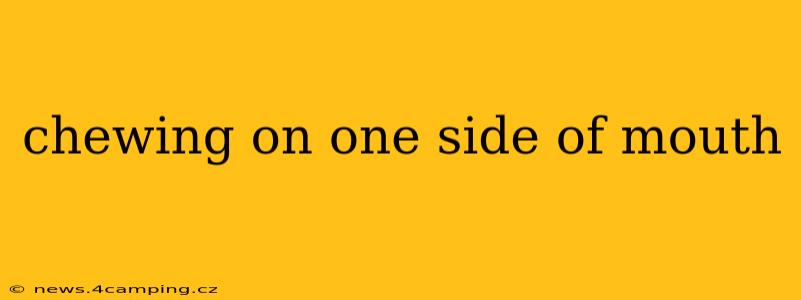Chewing predominantly on one side of your mouth is a common habit many people experience without realizing it. While it might seem harmless, consistently favoring one side can lead to several oral health issues. This comprehensive guide explores the potential reasons behind this habit, the associated risks, and effective strategies to address it.
Why Do I Chew on One Side of My Mouth?
This seemingly simple question has several possible answers. Let's explore some of the most common causes:
1. Existing Dental Problems:
Perhaps the most significant reason for one-sided chewing is the presence of underlying dental issues. Pain, discomfort, or sensitivity in teeth, gums, or jaw joints on one side can naturally lead you to avoid chewing on that side. This could stem from:
- Cavities or Fillings: A sensitive tooth due to decay or a poorly fitting filling can make chewing painful.
- Gum Disease: Inflamed or infected gums can make chewing uncomfortable.
- Temporomandibular Joint (TMJ) Disorders: TMJ disorders affect the jaw joint, causing pain and limited movement. Chewing on the affected side can exacerbate pain.
- Missing Teeth or Dental Implants: The absence of teeth on one side will naturally make chewing on that side difficult or uncomfortable.
2. Habitual Preference:
Sometimes, there's no underlying medical reason; it's simply a matter of habit. Many people develop a preference for chewing on one side without even realizing it, perhaps starting in childhood. This can become ingrained over time.
3. Muscle Imbalance:
Prolonged chewing on one side might lead to muscle imbalance in the jaw and face. This imbalance could then further reinforce the habit. One side of the jaw might become stronger and more efficient at chewing, making it feel more natural to continue using that side.
What Are the Risks of Chewing on One Side?
While occasional one-sided chewing isn't typically a cause for concern, consistent unilateral chewing can have several negative consequences:
- TMJ Problems: As mentioned, continually favoring one side can strain the jaw joint, leading to TMJ disorders characterized by pain, clicking, and limited jaw movement.
- Facial Asymmetry: Over time, uneven chewing can contribute to facial asymmetry, as the muscles on one side develop more than the other.
- Dental Issues: Uneven wear and tear on teeth can lead to problems like premature wear, sensitivity, and even temporomandibular joint dysfunction (TMD).
- Muscle Pain: Muscle imbalances from consistent one-sided chewing can cause headaches, jaw pain, and neck pain.
How Can I Stop Chewing on One Side?
Addressing this habit requires conscious effort and potentially professional help. Here are some strategies:
1. Identify the Root Cause:
Schedule a dental check-up. Your dentist can identify any underlying dental problems that might be contributing to your one-sided chewing habit.
2. Conscious Awareness:
Pay close attention to your chewing patterns throughout the day. Notice when you unconsciously gravitate towards one side. This awareness is the first step towards changing the habit.
3. Deliberate Switching:
Consciously switch sides while chewing. Start by trying to chew a few bites on the other side. Gradually increase the duration and frequency of chewing on the less-favored side.
4. Soft Foods:
If you experience pain, opt for softer foods that are easier to chew on either side. This can help reduce discomfort and encourage more even chewing.
5. Physiotherapy or Occlusal Splints:
In cases of severe TMJ problems, a physiotherapist or dentist might recommend exercises or an occlusal splint (a mouthguard) to help relieve pain and restore jaw function.
6. Seek Professional Help:
If you suspect an underlying medical condition contributing to your one-sided chewing habit, consult your doctor or dentist. They can provide appropriate guidance and treatment.
By addressing the underlying causes and actively working to change your chewing habits, you can mitigate the potential risks associated with unilateral chewing and maintain optimal oral health. Remember that consistency is key; it takes time to establish new habits.
